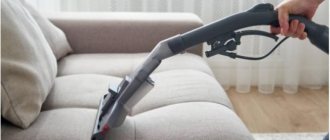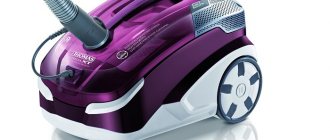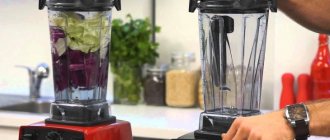Purpose and functions of a washing vacuum cleaner
A washing vacuum cleaner is a household appliance that can perform wet cleaning. This is a multifunctional unit. Most of them also perform dry cleaning. After all, before washing you need to collect dust.
Functions of washing vacuum cleaners:
- Collect liquids (except for gasoline, acetone, and other aggressive agents).
- Clean hard surfaces and upholstered furniture, carpets, removing dust and stains.
- Wash vertical surfaces (glass, mirrors).
- Remove the most difficult stains with steam (steam function).
- Clean curtains.
- Clean up pet hair.
- Humidify and scent the air.
A vacuum cleaner with an aqua filter is not a detergent by definition. After all, in it the dust collected during dry cleaning gets wet inside the device before going into the dust collector. The surface itself remains dry and is not affected by water. The washing vacuum cleaner TWIN TT Aquafilter is equipped with an aquafilter. With its help, he performs dry cleaning, and during washing, water is supplied to the surfaces being cleaned.
The principle of operation of the washing “cleaner”
The algorithm for carrying out standard cleaning is known. First, the housewife collects dust and debris with a regular vacuum cleaner, then arms herself with a bucket of water and a rag to wash the floor. If the house has a washing vacuum cleaner, these two stages can be performed simultaneously.
The unit sucks up dust and small debris. After this, it delivers a stream of clean water to the floor surface, which it immediately absorbs and disposes of in a separate container. As a result, cleaning time is reduced, and its quality, according to reviews, is significantly improved.
A good washing vacuum cleaner is accompanied by detailed instructions that need to be studied, as well as a set of documents that confirm the quality of the device
Some models of washing vacuum cleaners make it possible to spray water in separate streams. This is useful where you need to deal with complex contaminants.
A great addition is the steam function. Such a unit is more expensive, but helps to cope with even the most complex contaminants.
Attachments designed for processing various surfaces improve the quality of cleaning with a washing vacuum cleaner. Often there is a compartment in the device body for storing them.
Inside the washing vacuum cleaner there are two reservoirs: with clean and dirty water. Before you start cleaning, the first one needs to be filled, and the second one should be clean and dry by this time. The device is serviced immediately after each cleaning cycle.
The cleaning liquid enters through the spray capillary and is almost immediately sucked into the main pipe and then transferred to the dirty water compartment
When purchasing a vacuum cleaner, you should pay attention to the volume and position of the tanks. The optimal size of the container should allow you to completely treat the entire floor area without the need to add clean water to the device.
The location of the containers depends on the model and can be different:
- next to each other;
- one above the other;
- a tank inside another tank.
It is important to understand which container, “clean” or “dirty,” is removed first when servicing the unit. It is more convenient to start cleaning it after cleaning if you can first remove the tank with dirty water.
If, due to the large area or modest size of the model, you need to add clean water, it is better to take a model with access to a “clean” container. Most often, manufacturers use the last option, a tank in a tank, as it is considered the most convenient.
The vacuum cleaner usually comes with the necessary chemicals for wet cleaning: concentrated shampoo and defoamer, although low-foam formulations are also available on sale. When using them, you will not need a foam damper
The cleaning process also involves a detergent that must be dissolved in clean water. Mixing is usually done in a separate container and then poured into an appropriate container. The solution is supplied through a special capillary tube. It is usually located along the hose and suction pipe, inside or outside.
TOMAS vacuum cleaners are equipped with a special water box, which is used as a water filter during dry cleaning, and is designed to collect dirty water during wet cleaning.
Most often, the spray hose is located outside and is fixed on the surface of the telescopic tube with special clips. This design is typical for models that are designed for both dry and wet cleaning. When the spray elements are not needed, they can simply be removed.
During the cleaning process, the cleaning composition is sprayed onto the floor in front of the cleaning nozzle, then washed off with water, which is sucked up by the main pipe. Good suction power is the most important characteristic of a washing vacuum cleaner. There are models with and without filters; the principles of caring for such devices differ markedly.
If the washing vacuum cleaner has several filter elements, after each cleaning they need to be removed, washed and dried, and periodically replaced with new ones.
Modern HEPA filters are good at keeping even fine dust inside, but they need constant cleaning and periodic replacement.
If a worn filter is not replaced in time, the suction performance of the vacuum cleaner will deteriorate and the overall quality of cleaning will decrease. Models that do not have filters do not have this problem.
Design and principle of operation
Washing vacuum cleaners are designed in the same way as dry cleaning devices. But any of them is equipped with two containers: for clean water and used, dirty water. The design of a washing vacuum cleaner differs in the location of the tanks. They can be next to each other or vertically. In some appliances, clean dishes are installed inside a waste water container.
This is due to the need to make the device less bulky.
It conflicts with the desire to clean dirty water dishes as little as possible. Therefore, many modern models have a much larger reservoir for it (up to 4 times) than for clean water. This allows you to add liquid several times during cleaning and not waste time cleaning the device. Attention! To add water, be sure to first turn off the device from the network.
Then open the lid, take out the empty tank and add water to it. Place it in place and close the lid. They continue to work. An important design element is the water supply system from the reservoir to the surface to be cleaned. Each manufacturer has its own tricks, although the operating principle of a washing vacuum cleaner is not significantly different. The process is constantly being improved to avoid leaks and make the amount of liquid supplied optimal. To prevent water from spoiling the material, it is not supplied in a stream, but sprayed on the surface. A capillary tube is used for this. It is attached to the handle and base of the nozzle from the outside or inside. In products that collect garbage and wash floors, the tube can be attached with special clips and removed at the user’s request.
Water falling on the floor or glass dissolves the remaining dust on them. The resulting dirt must be quickly removed from the surface. The nozzle has a nozzle through which waste water is sucked into the vacuum cleaner and sent to the tank designated for it. It is hermetically sealed, so dirt particles will not re-enter the surface.
The cleaning result will be better if water is supplied to the surface in thin streams. Such models will cope perfectly with heavy pollution. It’s even better if the device is equipped with a steam function.
How to remove water using a simple vacuum cleaner?
First, make a small device to collect water. To do this, take some kind of container, for example, a three-liter jar with a plastic lid, a canister, a bucket with a lid, etc.
An important condition is that the lid must close tightly.
First option
Materials:
- three-liter jar;
- plastic cover;
- quick-release connections for pumps (can be replaced with hoses and silicone sealant);
- propylene hose (or any other suitable diameter);
- a piece of garden hose (for connecting to a vacuum cleaner);
- plug (lid from a five-liter canister).
Manufacturing:
- Make two holes in the jar lid for quick-release connections and secure them.
- If you have hoses, install them and carefully apply sealant at the joints. Insert the hoses into the quick releases. The lid is put on the jar.
- Insert a thick hose into the hole in the vacuum cleaner gun, and close the suction hole with a plug.
Turn on the vacuum cleaner and get to work.
Second option
Materials:
- bucket with lid;
- siphon for sink – 2 pcs.
Manufacturing:
- Make two holes in the lid of the bucket. Install siphons in them.
- Connect a hose to one of them, and lower the second one into the water that needs to be pumped out.
This method is suitable for quickly pumping water out of basements and various recesses.
This video describes the assembly process and clearly shows how and what volume of water can be pumped out:
Third option
The principle of collecting the water intake is the same as in previous cases.
Materials:
- plastic container with a screw cap, volume 1.5 l;
- sewer corner with a diameter of 32 mm;
- sewer pipe with a diameter of 32 mm;
- two hoses of suitable diameter;
- tea sieve.
From this video you will learn several interesting life hacks for securing tubes in the lid and see the assembly process “from A to Z”:
How to prepare for work, features of operation
Before using a washing vacuum cleaner, perform the following procedures:
- Prepare water by pouring it into additional dishes. A special detergent is added to it.
- Open the lid of the clean water tank and pour in the resulting composition. Dishes that are dirty are dry at the start of cleaning.
- Connect the capillary tube to the body and the selected nozzle. Attached to a telescopic pipe depending on how the particular washing vacuum cleaner is designed.
- Install the hose into the connector on the housing, and connect the suction pipe on the other side.
- Connect to the mains.
Some models require additional procedures. For example, a defoamer is added to the dirty water container of devices with filters.
Before using a vacuum cleaner for dry cleaning, do not pour liquid into the clean water tank. In units with an aquafilter, clean water is poured into the used container.
Which means to choose
To treat furniture, detergent is added to the water. The proportions can be found in the instructions for the device. Typically, vacuum cleaner manufacturers offer owners to use their brand of shampoo. They consist of water and surfactants (normally their capacity should not exceed 15%), inorganic salts, flavorings and preservatives, which increase the shelf life of the product.
It is better to give preference to products from well-known manufacturers. It is less dangerous to health to use shampoo without chlorine and phosphates, without fragrances that can cause allergies. If the model is equipped with a filter, it is advisable to buy a product that already contains a defoamer.
To find out how a washing vacuum cleaner works with colored materials, experts advise applying the prepared working solution to a small area in an inconspicuous place. If the color does not change, you can pour it into the tank and start cleaning.
What can be washed
Wooden floors, tiles, linoleum, hard surfaces that are not afraid of water - something that can almost always be washed with a vacuum cleaner. But this type of cleaning is also suitable for cleaning soft and delicate materials. It needs to be done correctly. This applies, in particular, to parquet and laminate.
For washing window glass, we have our own washing vacuum cleaners and portable glass cleaners. They can operate from an electrical network or from a battery. The operating instructions for a window washing vacuum cleaner indicate that it is also used for cleaning tiles, mirrors, and ceramic tiles. The advantage over the traditional unit is its small size and weight. It is easy to hold in your hands and can be lifted up. It differs from a robot in that it cannot move independently according to a predetermined pattern.
Flaws
A washing vacuum cleaner also has its disadvantages:
- Surfaces covered with thick pile cannot be cleaned.
- It is impossible to dry a surface with pile to a dry state.
- The labor-intensive procedure of washing the vacuum cleaner itself after cleaning.
- The device is large in size, which is especially inconvenient for small apartments.
- High price.
- High power consumption.
- Do not use the device for cleaning floor coverings that are susceptible to moisture - wooden floors, parquet.
Rules for use with various types of coatings
Some materials require special handling when cleaning. Jute surfaces can lose color and even become deformed when exposed to water. Therefore, they must be handled with a washing vacuum cleaner with extreme caution.
Upholstery and multi-colored carpets are not as susceptible to moisture, but they can be sensitive to detergents. Therefore, it is better to reduce their concentration in water.
When cleaning curtains, you need to reduce the suction force of the device as much as possible. If this is not done, it may damage or tear them.
Some users are afraid to clean high-pile carpets. They are afraid that they will not be able to collect all the moisture. The carpet will not be able to dry, mold will grow there, which will render the product unusable. To prevent this from happening, cleaning should be done outdoors in the summer. Additionally, the wet product is treated with a brush in the direction of the pile.
Most models are equipped with a set of attachments for processing different materials. The telescopic pipe and adapters make cleaning with a washing vacuum cleaner convenient and adapt to the surface as much as possible.
Example of using Karcher Puzzi
Karcher is one of the most famous manufacturers of cleaning equipment. How to use a Karcher Puzzi industrial vacuum cleaner will help you get a more accurate idea of how to use these complex units.
Before starting work, the manufacturer recommends checking the condition of the power cable and suction hose each time.
After this, the following elements are connected in series:
- nozzle - fixed with a union nut;
- suction pipe;
- elbow - fixed with a union nut;
- suction hose;
- spray hose.
The collected elements are connected to a washing vacuum cleaner. In this case, the suction hose is first inserted into the socket on the body, and then the connection between this element and the spray hose is made with the elbow. Particular attention should be paid to the junction of the spray hose with the elbow; a special coupling is designed for this.
In a separate container, you need to mix the detergent composition and clean water in the proportions that are recommended for this particular product. It is better to use warm water (no more than 50°C) to increase cleaning efficiency. In this case, you need to make sure that the coating can withstand contact with warm liquid without damaging its condition.
If you intend to clean delicate surfaces (colored carpet, upholstery), you first need to test the detergent composition and the temperature of the working fluid in an inconspicuous area
The prepared solution is poured into a “clean” container up to the MAX mark. Now you can connect the vacuum cleaner to the power supply. Then press the SUCTION and SPRAY knobs to begin the cleaning procedure.
First, it is recommended to check the resistance of the coating to moisture and cleaner in some inconspicuous place. If the color and texture of the carpet remain unchanged, cleaning can continue. To supply the cleaning solution to the surface, a special lever is provided on the elbow of the washing vacuum cleaner.
The nozzle is moved along the floor covering in such a way that “paths” are formed with a slight overlap. The nozzle cannot be moved in any direction; only reverse motion is used. For periods when direct cleaning needs to be suspended, the nozzle can be hidden in the slot provided for this purpose on the handle.
After the coating has been treated with the solution, you can go over it again without splashing, as with dry cleaning. This will speed up the drying of the surface. When working with areas where there is heavy contamination, it is recommended to spray the composition and pause for about a quarter of an hour.
Before you start cleaning, you need to pour clean water with shampoo dissolved in it into the appropriate container. The concentration and method of dilution depends on the type of product and is indicated in the instructions for it
A short break ensures contact of the composition with dirt and increases cleaning efficiency. After this, you need to treat the surface again as during normal cleaning, and then again, but using only clean water.
When working with chemical-sensitive surfaces (multi-colored carpets, upholstery), you can reduce the concentration of the special product.
Particular care should be taken when working with jute surfaces, which are prone to color loss and deformation when in contact with moisture. For high-pile carpets, after cleaning, additional treatment with a brush or broom in the direction of the pile is recommended. This must be done before the surface dries.
When the cleaning process is completed, first move the SUCTION and SPRAYING handles to their original position, after which the vacuum cleaner can be unplugged. Now it is important to correctly carry out the maintenance procedure for the device. First, empty the “dirty” tank.
To do this, open the housing lid, take out the container and pour the waste water out of it. Do the same if this tank overflows during cleaning. First, of course, you need to unplug the vacuum cleaner and turn the switches.
Then you need to remove and empty the container, put it in place and perform the reverse operations: turn on the device and move the SUCTION and SPRAYING handles to the working position. At the end of cleaning, the compartment is washed with running water.
Now you should empty the “clean” container of any remaining liquid.
They do it like this:
- disconnect the vacuum cleaner from the network;
- relieve pressure inside; for this purpose, there is a lever located on the knee;
- disconnect the spray hose;
- lower the main hose into a container of water;
- turn on the vacuum cleaner and move the SUCTION handle;
- wait until the device pumps the liquid out of the container.
The next stage is washing the working elements of the device. The elbow is connected to the main hose and capillary. Now approximately two liters of ordinary clean water are poured into a “clean” container. There is no need to use a cleaning compound here.
Now you need to turn on the spray SPRAY. The washing process takes one or two minutes. Then the vacuum cleaner should be turned off. Once both tanks are cleaned, they need to be dried. The outside of the housing is wiped with a damp cloth, and its lid is left in the open position while drying.
If servicing a washing vacuum cleaner seems too difficult, you can choose a different type of unit. Models with an aqua filter demonstrate good cleaning quality.
Maintenance and after-work care
After finishing wet cleaning, the dirty water is poured out. The cleaning process itself depends on what filters the unit is equipped with.
If there is a HEPA filter, it must be constantly cleaned and changed periodically. Usually this needs to be done once every six months, because its resource is 30 hours of use. The operating time depends on how often the vacuum cleaner is used and what it does. If you do not change the filter, the quality of cleaning will deteriorate.
Note! If you buy a separator type vacuum cleaner, there will be no problems with replacing filters. They simply aren't there. At the same time, the quality of cleaning with such units is higher.
A turbine is installed inside the separator vacuum cleaner. It creates an area with increased pressure, under the influence of which all dirt, including the smallest dust and allergens, is sent to the waste water container.
Typically, after wet cleaning, the following operations are performed:
- Disconnect the device from electricity.
- Release the pressure in the liquid sprayer.
- Remove the waste water tank.
- They pour it down the drain.
- Remove any remaining clear liquid.
- Wash tanks and hoses with running water.
- Clean filters.
- Dry all washed parts.
Attention! Assemble the device when all the elements have dried well. If you stack them wet, the parts will become moldy.
A washing vacuum cleaner greatly simplifies the process of cleaning the house. The device will be useful even if there is already a robot that performs cleaning on a schedule. Self-service vacuum cleaners are used at car washes. They clean the interior and luggage compartment.
Application
The functionality of this unit significantly exceeds the capabilities of a conventional vacuum cleaner, which is usually used only at the preliminary stage before wet cleaning.
Its washing counterpart differs precisely in that it combines the ability to do both. Let's take a closer look at its capabilities.
Washing and wet cleaning of various surfaces
What can be washed
It is worth remembering that with all the advantages of such a unit, it cannot be used for all coatings. For example, it is strictly forbidden to clean parquet or natural pile carpets with moisture, as it penetrates into them and these coatings begin to rot from the inside.
But no problems will arise with the following surfaces:
- linoleum;
- carpets made of unnatural pile;
- laminated coatings;
- stone;
- ceramics;
- glass;
IMPORTANT! Before you start cleaning, make sure that the surface is resistant to moisture and will not be damaged by using the device.
If everything is in order, then you can begin to act.
Mode of application
- Fill the tank with clean water, assemble the device as described above.
- Then treat the entire surface. Start washing from the corner, controlling the brush overlapping. If there is a need and the equipment is not prohibited, use detergent.
- If there is a lot of dirt on the floor, you will need a little more mixture.
- Then clean the floor with clean water.
- After this, you can start drying. To do this, use a nozzle with a suction effect.
Thus, in just a few minutes the surface will be cleaned of dust and dirt.
Dry cleaning
The principles of dry cleaning have been familiar to us since the days of widespread use of ordinary vacuum cleaners. Therefore, everything is even simpler here.
The difference is that with this mode of operation there is no need to add water.
You will also need a suction attachment.
Walk over the entire surface once or twice with the vacuum cleaner turned on at full power - not a trace of dust will remain.











